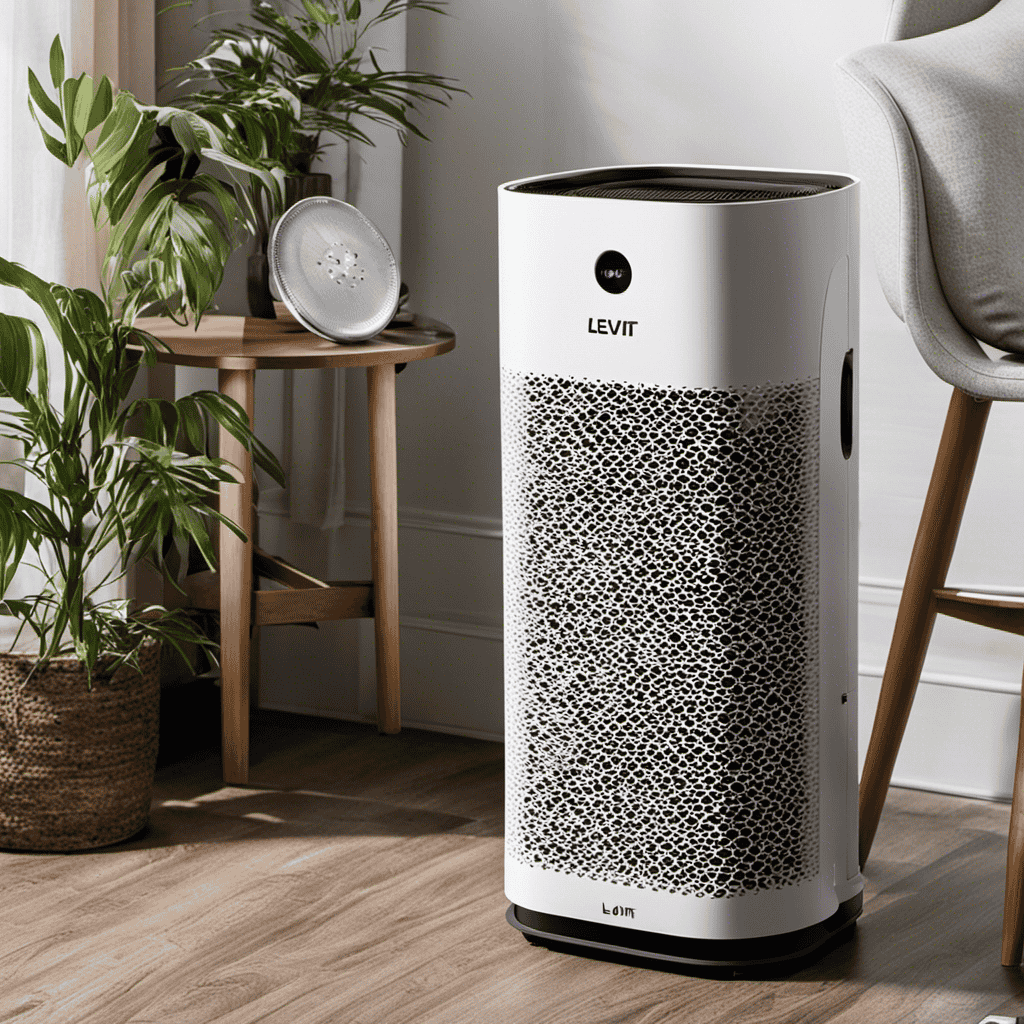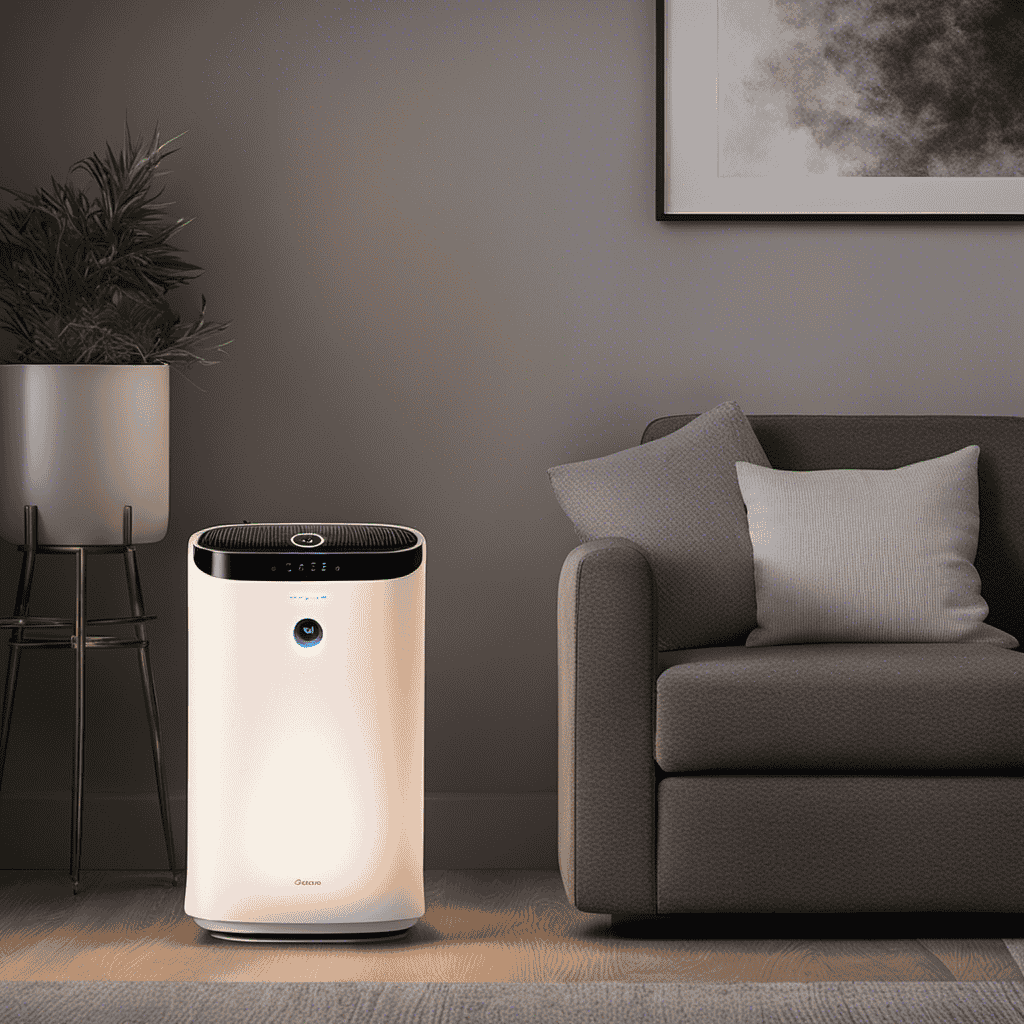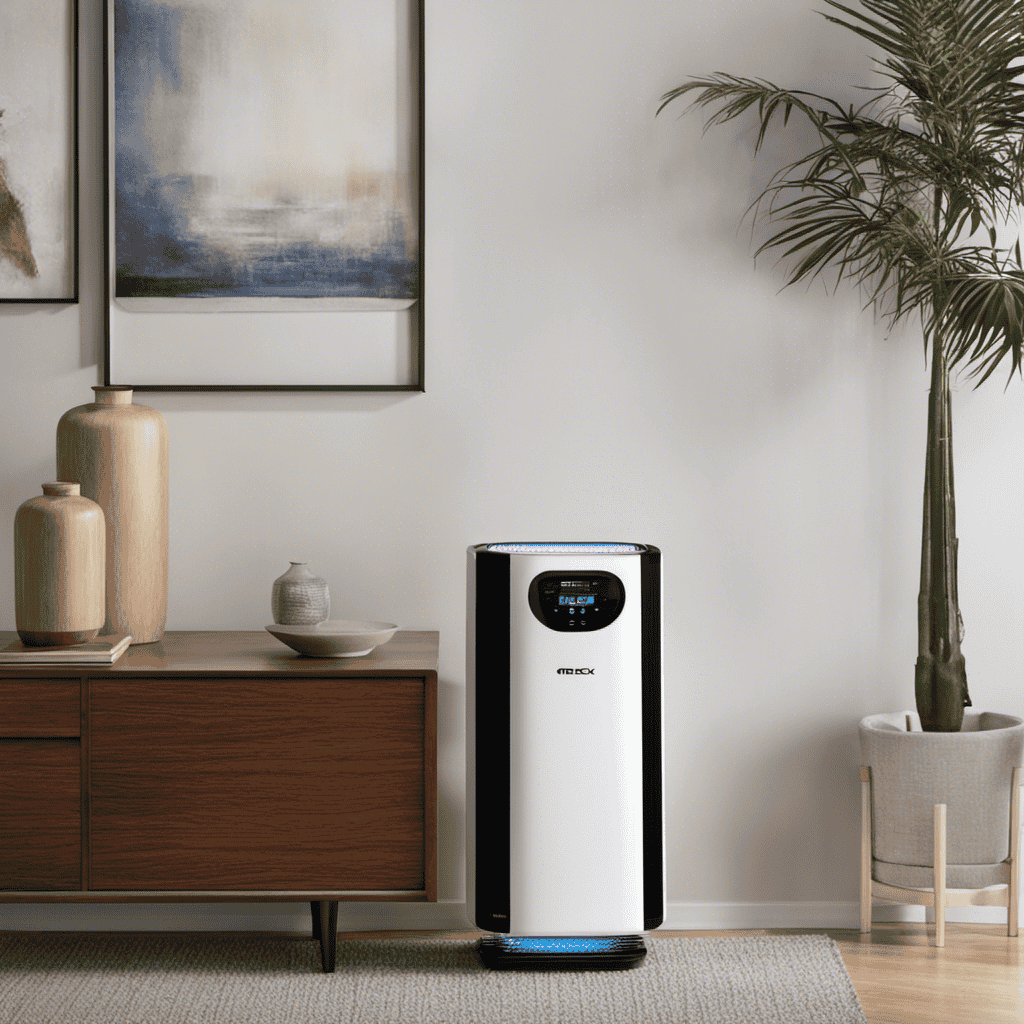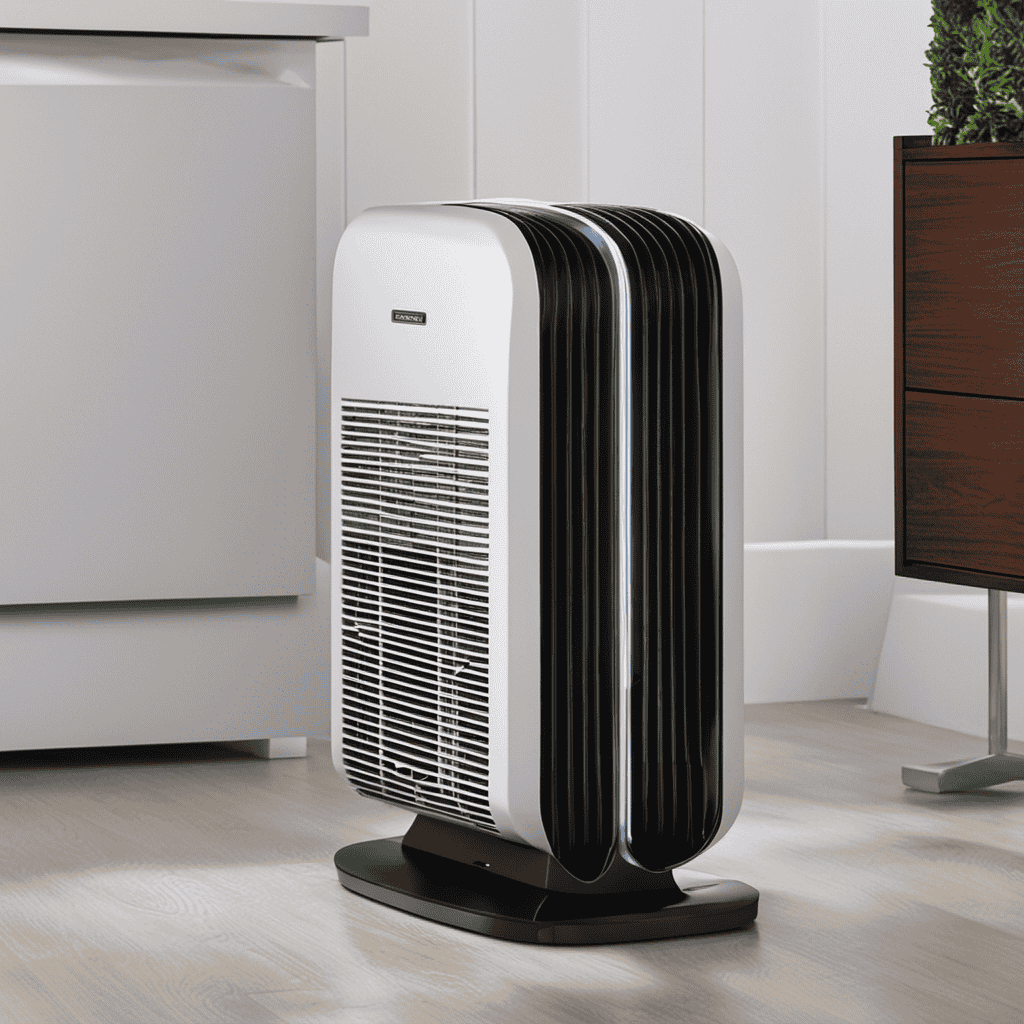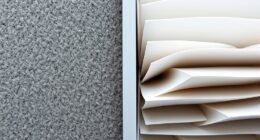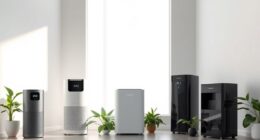I have exciting news for all Levoit Air Purifier owners! Today, I will demonstrate the proper way to replace the filter in your purifier.
Maintaining the filter is crucial for optimal performance and clean air in your home. In this article, I’ll guide you through the entire process, from identifying the right filter to troubleshooting common issues.
So, let’s get started and ensure your Levoit Air Purifier is working at its best!
Key Takeaways
- Regular filter maintenance is crucial for optimal performance and lifespan of the Levoit air purifier.
- Choosing the correct filter is important for the purifier’s effectiveness, and Levoit provides a comprehensive compatibility guide for reference.
- Different types of filters, such as HEPA filters, activated carbon filters, and pre-filters, target specific pollutants and should be replaced at recommended intervals.
- Proper filter replacement process and regular cleaning and maintenance of the air purifier improve efficiency, air quality, and prolong the purifier’s lifespan.
Understanding the Importance of Filter Maintenance
You need to understand why filter maintenance is important when using a Levoit air purifier.
Regular filter cleaning is essential to ensure the optimal performance of your air purifier. Over time, the filters in your purifier can become clogged with dust, allergens, and other particles, hindering their ability to effectively clean the air in your home. By regularly cleaning the filters, you can remove these accumulated particles and restore the air purifier’s efficiency.
Additionally, using genuine replacement filters is crucial for maintaining the effectiveness of your Levoit air purifier. Genuine filters are specifically designed for your purifier model and are made with high-quality materials, ensuring maximum filtration and longevity. Using non-genuine filters may compromise the performance of your air purifier and potentially void the warranty.
Therefore, it is essential to prioritize regular filter cleaning and the use of genuine replacement filters to optimize the performance and lifespan of your Levoit air purifier.
Identifying the Right Filter for Your Levoit Air Purifier
When it comes to maintaining your Levoit air purifier, one of the most important aspects is ensuring that you have the right filter for your specific model.
In order to help you with this, Levoit provides a comprehensive Filter Compatibility Guide that lists all the compatible filters for each air purifier model.
This guide is a valuable resource that allows you to easily identify and purchase the correct filter replacement options for your Levoit air purifier.
Filter Compatibility Guide
To determine if a filter is compatible with your Levoit air purifier, simply check the model number on the packaging. Each Levoit air purifier is designed to work with specific filters, and using the wrong filter can affect the performance of your purifier. To make it easier for you to find the right filter, I have created a table below that lists the compatible filters for different Levoit air purifier models.
| Levoit Air Purifier Model | Compatible Filters |
|---|---|
| LV-H132 | LV-H132-RF |
| LV-PUR131 | LV-PUR131-RF |
| LV-H133 | LV-H133-RF |
Filter Replacement Options
If you’re unsure about which replacement option to choose, refer to the compatibility guide for a list of compatible filters for your specific model.
When it comes to replacing the filter in your Levoit air purifier, it’s important to consider the filter replacement frequency. Here are three options to consider:
-
Pre-filter replacement: The pre-filter is the first line of defense against larger particles like dust and pet hair. It should be replaced every 3 months or as needed, depending on the level of pollutants in your environment.
-
True HEPA filter replacement: The True HEPA filter captures 99.97% of particles as small as 0.3 microns, including allergens and bacteria. It is recommended to replace this filter every 6-8 months for optimal performance.
-
Activated carbon filter replacement: The activated carbon filter helps eliminate odors and harmful gases. It is advised to replace this filter every 6 months or as needed, depending on the intensity of odors in your home.
To ensure the longevity and efficiency of your Levoit air purifier, it is essential to follow these filter maintenance tips and replace the filters regularly.
Gathering the Necessary Tools for Filter Replacement
Before starting the filter replacement process, make sure you have all the necessary tools. Understanding filter efficiency and the benefits of regular filter changes are crucial in maintaining a clean and healthy indoor environment.
The Levoit air purifier is designed to provide optimal air quality by capturing and removing pollutants and allergens from the air. To ensure its effectiveness, it is important to regularly change the filters.
The necessary tools for filter replacement include a new filter, a screwdriver (if required), and a clean cloth. Having these tools ready before starting the process will make it smoother and more efficient.
Regular filter changes not only improve the performance of the air purifier but also help in reducing allergy symptoms and keeping the air in your home fresh and clean.
Locating the Filter Compartment in Your Levoit Air Purifier
Once you’ve gathered the necessary tools, locating the filter compartment in your Levoit air purifier is the next step. Follow these simple instructions to find the filter compartment:
-
Turn off the air purifier and unplug it from the power source to ensure safety.
-
Locate the control panel on the front of the purifier. It usually has buttons and a display screen.
-
Look for a latch or a release button near the control panel. Press it to open the filter compartment.
Finding the filter compartment is crucial for Levoit air purifier filter replacement. It allows you to easily remove and install a new filter when needed. If you are troubleshooting filter issues, such as reduced airflow or strange odors, accessing the filter compartment is essential for inspection and maintenance.
Remember to consult the user manual for specific instructions on your model.
Removing the Old Filter From Your Levoit Air Purifier
When it comes to maintaining the efficiency of your Levoit Air Purifier, the filter replacement process is an essential step. To ensure that your air purifier continues to provide clean and fresh air, it’s important to understand the proper filter removal steps.
In this discussion, I will guide you through the detailed process of removing the old filter from your Levoit Air Purifier, providing you with the knowledge you need to keep your air purifier running smoothly.
Filter Replacement Process
To change the filter on your Levoit air purifier, simply follow these steps:
- Turn off the air purifier and unplug it from the power source for safety.
- Locate the filter compartment on the back or side of the unit. It is usually secured with tabs or screws.
- Open the compartment and carefully remove the old filter. Be sure to dispose of it properly.
- Take your new filter and remove any packaging or protective covers.
- Insert the new filter into the compartment, making sure it fits securely and aligns with any guide marks.
- Close the compartment and secure it with the tabs or screws.
- Plug in the air purifier and turn it back on. Your Levoit air purifier is now ready to provide you with clean, fresh air.
Understanding filter maintenance and the benefits of regular filter replacement are essential for maximizing the performance and lifespan of your Levoit air purifier. By regularly changing the filters, you ensure that the purifier continues to effectively remove airborne pollutants, allergens, and odors from your indoor environment.
This not only improves the air quality but also helps protect your health and well-being. Additionally, a clean filter allows the air purifier to operate efficiently, saving energy and prolonging the lifespan of the unit. So, make it a habit to check and replace your Levoit air purifier filters as recommended by the manufacturer.
Filter Removal Steps?
You can easily remove the filter by opening the compartment and carefully taking out the old one.
To begin the filter removal process in a Levoit Air Purifier, locate the filter compartment. This is usually located at the back or side of the purifier.
Gently open the compartment by pushing the latch or sliding the cover. Once the compartment is open, you will see the filter secured in place. Carefully grab hold of the filter and pull it straight out. Be cautious not to damage the filter or the purifier.
Dispose of the old filter properly. It is now ready for you to replace it with a new one.
Cleaning the Filter Compartment Before Installing a New Filter
Before installing a new filter, make sure to clean the filter compartment of your Levoit air purifier. This step is essential for maintaining the efficiency and longevity of your air purifier. Here are three cleaning techniques to prevent filter damage:
-
Remove the filter gently: Take out the old filter carefully to avoid any tearing or bending. This will prevent any debris or dirt from falling into the filter compartment.
-
Vacuum the compartment: Use a vacuum cleaner with a brush attachment to remove any dust or particles from the filter compartment. Be thorough and ensure all corners and crevices are cleaned.
-
Wipe with a damp cloth: Take a damp cloth and wipe the inside of the filter compartment to remove any remaining dirt or residue. This will help maintain a clean and hygienic environment for your new filter.
Choosing the Correct Replacement Filter for Your Levoit Air Purifier Model
When selecting the right replacement filter for your Levoit air purifier model, it’s important to consider the specific model number and filter type.
Levoit offers a range of replacement filter options, each designed to target different pollutants and allergens in the air. The most common filter types include HEPA filters, activated carbon filters, and pre-filters.
HEPA filters are highly effective in capturing small particles like dust, pollen, and pet dander, while activated carbon filters excel at removing odors and harmful gases. Pre-filters are designed to trap larger particles and prolong the lifespan of the main filter.
To ensure optimal performance, it’s essential to follow filter maintenance tips such as regularly checking and replacing the filter as recommended by the manufacturer.
Unboxing and Inspecting the New Filter Before Installation
When it comes to replacing filters in my Levoit air purifier, I always prioritize filter quality and lifespan. I understand that a high-quality filter is essential for effectively removing pollutants and allergens from the air, while a longer lifespan ensures that I get the most out of my investment.
That’s why proper inspection before installation is of utmost importance to ensure that the filter meets the required standards and is in pristine condition.
Filter Quality and Lifespan
The filter’s quality and lifespan can greatly affect the performance of the Levoit air purifier. Ensuring proper filter maintenance is essential for optimal functioning. Here are three factors that can affect the lifespan of your air purifier filter:
-
Usage: The frequency and duration of use can impact how quickly the filter gets clogged. If you use the air purifier in a highly polluted area or run it continuously, the filter may need to be replaced more frequently.
-
Air quality: The level of pollutants in your environment can also impact the filter’s lifespan. If you live in an area with high levels of pollution or allergens, the filter may get saturated faster, requiring more frequent replacements.
-
Filter quality: Investing in a high-quality filter can prolong its lifespan. Look for filters with HEPA or activated carbon technology, as they are more efficient at capturing pollutants and tend to last longer.
Importance of Proper Inspection
To ensure optimal performance, it’s important that you properly inspect your filter on a regular basis. Proper inspection techniques are essential for maintaining the efficiency and longevity of your filter.
By inspecting your filter regularly, you can identify any signs of wear and tear, clogging, or damage. This allows you to take immediate action and prevent any potential issues that may affect the performance of your Levoit air purifier.
Regular filter maintenance offers numerous benefits. It improves the overall air quality in your home by removing dust, allergens, and other pollutants more effectively. It also helps to prolong the lifespan of your filter, reducing the need for frequent replacements.
Now that you understand the importance of proper inspection, let’s move on to the next step: installing the new filter in your Levoit air purifier.
Installing the New Filter in Your Levoit Air Purifier
You’ll need to carefully remove the old filter before installing the new one in your Levoit Air Purifier. Here are some important steps to follow for a successful filter installation:
-
Troubleshooting filter installation: If you encounter any difficulties while removing the old filter, refer to the user manual for troubleshooting tips. It’s important to handle the filter with care to avoid damaging it or the purifier.
-
Maximizing filter efficiency: Before installing the new filter, make sure to clean the purifier’s housing to remove any dust or debris. This will help prevent contaminants from getting trapped in the new filter and ensure optimal air purification performance.
-
Proper alignment: When placing the new filter in the purifier, ensure that it is aligned correctly with the filter housing. This will prevent air leaks and ensure that all the air passing through the purifier is properly filtered.
By following these steps, you can ensure a smooth filter installation process that maximizes the efficiency of your Levoit Air Purifier.
Once the new filter is installed, it’s important to secure it in place to ensure proper functionality.
Securing the Filter in Place to Ensure Proper Functionality
Once you’ve completed the filter installation process, make sure to securely fasten it in place for optimal functionality. Ensuring proper filter installation is crucial for the Levoit air purifier to effectively clean the air in your home. To troubleshoot filter replacement issues, refer to the table below for common problems and solutions:
| Problem | Solution |
|---|---|
| Filter not fitting properly | Double-check the model number and size of the filter. Contact Levoit customer support for assistance. |
| Filter not sealing tightly | Ensure all tabs or clasps are securely fastened. Adjust the filter and try again. |
| Air purifier not turning on | Check if the filter is installed correctly. If not, remove and reposition it. |
Resetting the Filter Replacement Indicator on Your Levoit Air Purifier
After securing the filter in place to ensure proper functionality, it’s important to know how to reset the filter replacement indicator on your Levoit Air Purifier. This indicator serves as a reminder to change the filter when it has reached its maximum lifespan. By resetting it, you can effectively prolong the filter’s lifespan and maintain the air purifier’s performance.
Here are three simple steps to reset the filter replacement indicator:
-
Locate the control panel on your Levoit Air Purifier. It is usually located on the top or front of the unit.
-
Press and hold the filter replacement indicator button for approximately 5 seconds. This button is typically labeled as ‘Reset’ or has an icon resembling a filter.
-
Once the indicator light turns off or resets to its initial state, you have successfully reset the filter replacement indicator.
Extending the Lifespan of Your Levoit Air Purifier Filter
To effectively extend the lifespan of your Levoit Air Purifier filter, it’s essential to regularly clean and maintain it. Proper filter maintenance not only ensures that your air purifier continues to function effectively, but it also offers several benefits.
Firstly, regular cleaning removes accumulated dust, pet dander, and other particles from the filter, preventing them from clogging the airflow and reducing the purifier’s efficiency. This not only improves the air quality in your home but also helps to prolong the lifespan of the filter itself.
Additionally, cleaning the filter regularly helps to prevent the growth of mold and bacteria, which can accumulate over time and potentially be released back into the air. By taking the time to clean and maintain your Levoit Air Purifier filter, you can enjoy cleaner air and a longer-lasting filter.
Establishing a Filter Replacement Schedule for Optimal Performance
You should establish a regular schedule for replacing your filter to ensure optimal performance of your air purifier. Here are three important reasons why establishing filter replacement frequency is beneficial:
-
Improved Air Quality: Regularly changing the filter helps maintain clean and healthy air in your living space. Over time, filters accumulate dust, allergens, and other particles, which can reduce their effectiveness. By replacing the filter as recommended, you can ensure that your air purifier continues to remove contaminants efficiently.
-
Enhanced Efficiency: A clogged or dirty filter can strain your air purifier’s motor and decrease its efficiency. By replacing the filter on time, you help maintain the unit’s optimal performance, allowing it to purify the air more effectively and efficiently.
-
Prolonged Lifespan: Regular filter changes prevent excessive wear and tear on the air purifier’s components. By avoiding unnecessary strain on the motor and other parts, you can extend the lifespan of your Levoit air purifier, saving you money in the long run.
Troubleshooting Common Issues During Filter Replacement
When it comes to replacing filters in your air purifier, there are a few common issues that can arise.
One of these is incorrect filter installation, which can lead to decreased performance and potential damage to the unit.
Another issue is when the filter does not fit properly, causing gaps and allowing unfiltered air to bypass the system.
Lastly, an airflow obstruction may occur after filter replacement, which can be caused by a variety of factors such as a dirty fan or a clogged air intake.
Incorrect Filter Installation
If the filter isn’t installed correctly, the Levoit air purifier may not effectively clean the air in your home. To avoid common mistakes and ensure proper installation, follow these troubleshooting steps:
-
Check the filter orientation: Make sure the arrows on the filter align with the arrows on the purifier. Installing the filter upside down or backwards can hinder its performance.
-
Secure the filter properly: Ensure that the filter is securely locked in place. If it’s loose or not properly seated, it may not function effectively.
-
Remove any plastic wrapping: Before installing the filter, make sure to remove any plastic wrapping or protective covers. Leaving them on can obstruct the airflow and reduce the purifier’s efficiency.
Filter Not Fitting Properly
To ensure proper performance, make sure the filter is securely locked in place and oriented correctly.
If your filter is not fitting properly, it can lead to reduced air purification efficiency and potentially cause issues with your Levoit air purifier.
Troubleshooting filter issues involves checking if the filter is the correct size and type for your specific model. It is important to consult the user manual or the manufacturer’s website to find the compatible replacement filters for your Levoit air purifier.
Additionally, inspect the filter housing for any obstructions or damage that may prevent the filter from fitting correctly.
If you are still experiencing difficulties, contacting Levoit customer support can provide further assistance in resolving the issue.
Airflow Obstruction After Replacement
After replacing the filter, check for any obstructions that could be affecting the airflow in your device. This is one of the most common problems users face with their Levoit air purifiers. Here are some troubleshooting tips to help you resolve this issue:
-
Inspect the area around the air purifier for any objects or furniture that may be blocking the airflow. Ensure that there is at least a foot of clearance on all sides of the device.
-
Check the air vents and intake grille for any dust or debris that may have accumulated. Use a soft brush or vacuum cleaner to clean these areas.
-
Make sure that the filter is properly installed and securely in place. If it is not fitted correctly, it can restrict the airflow. Double-check the filter installation according to the manufacturer’s instructions.
Cleaning and Maintaining Your Levoit Air Purifier’s Exterior
Cleaning and maintaining your Levoit Air Purifier’s exterior is important to ensure optimal performance. By following the right cleaning techniques and maintenance tips, you can keep your air purifier in top shape.
First, make sure to unplug the device before cleaning. Use a soft, damp cloth to wipe down the exterior, removing any dust or dirt that may have accumulated. Avoid using abrasive cleaners or solvents as they can damage the surface. For stubborn stains, you can use a mild detergent diluted in water. Remember to dry the exterior thoroughly before plugging the device back in.
Regularly check the air vents and intake grills for any blockages and remove any debris using a soft brush or vacuum cleaner.
Taking these simple steps will help prolong the lifespan of your Levoit Air Purifier and ensure it continues to provide you with clean and fresh air.
Frequently Asked Questions
How Often Should I Change the Filter in My Levoit Air Purifier?
I change the filter in my Levoit air purifier every 6 months to ensure optimal performance. Unfortunately, the filter cannot be washed and reused, so it’s important to replace it regularly for clean air.
Can I Wash and Reuse the Filter in My Levoit Air Purifier?
Washing filters may seem economical, but it’s not recommended for Levoit air purifiers. Reusing filters can compromise their performance and effectiveness. Instead, opt for original brand filters to ensure maximum filtration and clean air.
What Should I Do if I Accidentally Damage the Filter During Replacement?
If I accidentally damage the filter during replacement, I would recommend being cautious and gentle when handling it. To prevent filter damage, follow the manufacturer’s instructions carefully and avoid any rough or forceful movements.
Can I Use a Generic Filter Instead of the Levoit Brand Replacement Filter?
Yes, you can use a generic filter as an alternative to the Levoit brand replacement filter. However, there are pros and cons to consider. Generic filters may be cheaper, but they may not provide the same level of filtration and could potentially affect the performance of the air purifier.
How Do I Know if the Filter in My Levoit Air Purifier Needs to Be Replaced?
I can tell if my air purifier’s filter needs changing by checking for signs of a dirty filter, like reduced airflow. Regular filter replacement is important for maintaining clean air quality in my home.
Conclusion
As I bid farewell to my trusty Levoit air purifier, I can’t help but reminisce about the journey we’ve had together.
From understanding the importance of filter maintenance to locating the filter compartment, it has been a whirlwind of knowledge and discoveries.
Through the ups and downs of troubleshooting common issues, I’ve learned the value of cleaning and maintaining its exterior.
So, as I embark on a new adventure with a fresh filter, I can’t help but feel a sense of excitement and gratitude for the clean and fresh air that awaits me.
